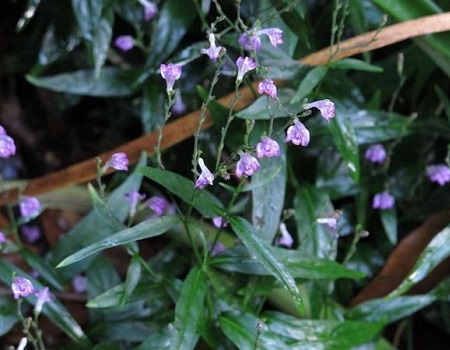Tilo
Not to be confused with linden trees (Tilia species), tilo (Justicia pectoralis) is a dark shade growing perennial ground cover. When I was in Panama I saw this plant growing in the wild. It was only found in the deepest darkest shade under thick forest canopy. Many people have difficulty growing this wonderful herb. Sometimes its because they don’t water them enough, but the problem is usually sunlight.

The leaves turn yellow, and start dropping off, and people think its some sort of nutrient deficiency. Fertilizers and other amendments, won’t fix the problem. Moving the plant into more light, just finishes them off for good. The trick is that these plants need complete shade. No direct sun at all. I grow mine in the space between two large oak trees where they never get any direct light and the leaves are dark green and glossy. They’ve actually broken free, and are forming a bed of tilo around the pots.
I originally obtained this plant from a Cuban friend, who didn’t know much about it other than the fact that it was medicinal. As a child, his mother and grandmother would give him the tea when he would get sick. He got his plant from his mother’s garden. I took it, thanked him, and pretty much forgot about my new little unidentified plant. A few months later, I got sick…really sick. Laid up in bed with chills and pain everywhere, and aspirin didn’t even touch the fever. When my friend learned of my sickness, he brought me a mug of the tea and told me to drink it all. I did, reluctantly at first, but it actually tasted really good. An hour later, after sweating profusely, my fever was gone. This was just my own anecdotal experience, but let me tell you, I was a believer, and I have had many experiences like it since then. I still didn’t even know what this pretty little folk herb was. I finally found it in The Plants Of The Gods by Shultes and Hoffman. The flowers were the giveaway. They look like little purple orchids. Since then I have loved this little plant.
Tilo tea can be used at any time as a relaxing tonic. It has been shown to have anticoagulant properties as well.
Origin
Central and South America.
Binomial nomenclature
Justicia pectoralis.
Description
Tilo is a highly aromatic herb. It trails on the ground setting new roots as it grows. The 1″ long, simple, lanceolate, leaves are dark green, and glossy. The small purple tube shaped flowers, grow in panicles, and resemble tiny orchids.
Height
18″.
Temperature/Zone
This plant is highly tropical. It will begin to be damaged at temperatures below 45° F. Zone 10 or higher. In zones 9b and lower, it should be kept in a container, and moved inside during temperatures below 50° F.
Light
I cannot stress this enough. This plant is an understory shade lover. Bright shade is too much light. Even dappled sunlight is often too much light. Put this plant under taller plants, that are growing in the shade. If the leaves are turning yellow, it is most likely due to too much sun.
Water
This plant loves moisture. Do not let tilo dry out. If the soil is not kept evenly moist at all times, they will crash hard. It will snap back once you water, but loss of older foliage is often the result of water stress, causing the plant to become spindly and leggy. I like to keep them in a tray of water.
Fertilizer
All purpose fertilizer.
Cultivation
Justicia pectoralis likes very rich soil. They respond well to periodic pruning when they get leggy. This encourages denser growth of the foliage.
Pests
I have had scale insects, and mealy bugs on my specimens, but they are not particularly prone to attacks by insects or fungi.
